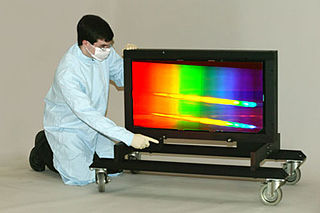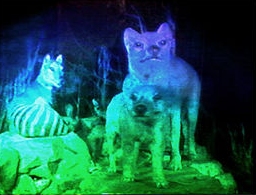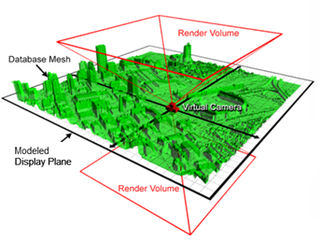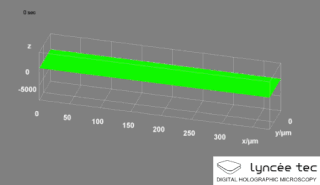Related Research Articles

In optics, a diffraction grating is an optical grating with a periodic structure that diffracts light, or another type of electromagnetic radiation, into several beams traveling in different directions. The emerging coloration is a form of structural coloration. The directions or diffraction angles of these beams depend on the wave (light) incident angle to the diffraction grating, the spacing or periodic distance between adjacent diffracting elements on the grating, and the wavelength of the incident light. The grating acts as a dispersive element. Because of this, diffraction gratings are commonly used in monochromators and spectrometers, but other applications are also possible such as optical encoders for high-precision motion control and wavefront measurement.

Holography is a technique that enables a wavefront to be recorded and later reconstructed. It is best known as a method of generating three-dimensional images, and has a wide range of other uses, including data storage, microscopy, and interferometry. In principle, it is possible to make a hologram for any type of wave.

Stereoscopy is a technique for creating or enhancing the illusion of depth in an image by means of stereopsis for binocular vision. The word stereoscopy derives from Greek στερεός (stereos) 'firm, solid', and σκοπέω (skopeō) 'to look, to see'. Any stereoscopic image is called a stereogram. Originally, stereogram referred to a pair of stereo images which could be viewed using a stereoscope.

A 3D display is a display device capable of conveying depth to the viewer. Many 3D displays are stereoscopic displays, which produce a basic 3D effect by means of stereopsis, but can cause eye strain and visual fatigue. Newer 3D displays such as holographic and light field displays produce a more realistic 3D effect by combining stereopsis and accurate focal length for the displayed content. Newer 3D displays in this manner cause less visual fatigue than classical stereoscopic displays.

The rainbow hologram is a type of hologram that was invented in 1968 by Dr. Stephen A. Benton at Polaroid Corporation. Rainbow holograms are designed to be viewed under white light illumination, rather than laser light which was required before this. The rainbow holography recording process uses a horizontal slit to eliminate vertical parallax in the output image, greatly reducing spectral blur while preserving three-dimensionality for most observers. A viewer moving up or down in front of a rainbow hologram sees changing spectral colors rather than different vertical perspectives. Because perspective effects are reproduced along one axis only, the subject will appear variously stretched or squashed when the hologram is not viewed at an optimum distance; this distortion may go unnoticed when there is not much depth, but can be severe when the distance of the subject from the plane of the hologram is very substantial. Stereopsis and horizontal motion parallax, two relatively powerful cues to depth, are preserved.
Lloyd Cross is an American physicist and holographer.
Holographic interferometry (HI) is a technique which enables the measurements of static and dynamic displacements of objects with optically rough surfaces at optical interferometric precision. These measurements can be applied to stress, strain and vibration analysis, as well as to non-destructive testing and radiation dosimetry. It can also be used to detect optical path length variations in transparent media, which enables, for example, fluid flow to be visualised and analyzed. It can also be used to generate contours representing the form of the surface.

Yuri Nikolayevich Denisyuk was a Russian physicist and one of the founders of optical holography in the former Soviet Union. He is known for his great contribution to holography, in particular for the so-called "Denisyuk hologram". He was a full member of the Russian Academy of Sciences, doctor of physical and mathematical sciences, professor (1980).

A hogel is a part of a light-field hologram, in particular a computer-generated one. It is considered a small holographic optical element or HOE and that its total effect to that of a standard hologram only that the resolution is lower and it involves a pixelated structure. An array of these elements form the complete image of a holographic recording, which is typically displayed in 3D free-viewing device.
Computer-generated holography (CGH) is a technique that uses computer algorithms to generate holograms. It involves generating holographic interference patterns. A computer-generated hologram can be displayed on a dynamic holographic display, or it can be printed onto a mask or film using lithography. When a hologram is printed onto a mask or film, it is then illuminated by a coherent light source to display the holographic images.

Stephen Anthony Benton was the inventor of the rainbow hologram and a pioneer in medical imaging and fine arts holography. Benton held 14 patents in optical physics and photography, and taught media arts and sciences at Massachusetts Institute of Technology (MIT). He was the E. Rudge ('48) and Nancy Allen Professor of Media & Sciences, and the Director for Center for Advanced Visual Studies (CAVS) at MIT.

Australian Holographics was a laboratory based in Adelaide, South Australia. It was established in 1989 with the specific objective to produce high quality large format holograms. After two years of research and development, the company began commercial operations in 1991. The laboratory eventually shut down in 1998.
A holographic display is a type of 3D display that utilizes light diffraction to display a three-dimensional image to the viewer. Holographic displays are distinguished from other forms of 3D displays in that they do not require the viewer to wear any special glasses or use external equipment to be able to see the image, and do not cause the vergence-accommodation conflict.

Zebra Imaging was a company that developed 3D digital holographic images, hologram imagers and interactive 3D displays for government and commercial uses. The company offers digital holograms that are autostereoscopic, full-parallax and in monochrome or full-color. They have also developed a 3D Dynamic Display, which is capable of rendering holograms in real time; design work with 3D programs such as SketchUp and 123D Catch can be viewed on a holographic display while they are actively being edited.

Spinning mirror systems are used to build interactive 3D graphics and autostereoscopic visuals visible to multiple simultaneous viewers, since a different view can be perceived by each viewer depending on the angle of vision.

Digital holographic microscopy (DHM) is digital holography applied to microscopy. Digital holographic microscopy distinguishes itself from other microscopy methods by not recording the projected image of the object. Instead, the light wave front information originating from the object is digitally recorded as a hologram, from which a computer calculates the object image by using a numerical reconstruction algorithm. The image forming lens in traditional microscopy is thus replaced by a computer algorithm. Other closely related microscopy methods to digital holographic microscopy are interferometric microscopy, optical coherence tomography and diffraction phase microscopy. Common to all methods is the use of a reference wave front to obtain amplitude (intensity) and phase information. The information is recorded on a digital image sensor or by a photodetector from which an image of the object is created (reconstructed) by a computer. In traditional microscopy, which do not use a reference wave front, only intensity information is recorded and essential information about the object is lost.
A holographic optical element (HOE) is an optical component (mirror, lens, directional diffuser, etc.) that produces holographic images using principles of diffraction. HOE is most commonly used in transparent displays, 3D imaging, and certain scanning technologies.
Holographic interference microscopy (HIM) is holographic interferometry applied for microscopy for visualization of phase micro-objects. Phase micro-objects are invisible because they do not change intensity of light, they insert only invisible phase shifts. The holographic interference microscopy distinguishes itself from other microscopy methods by using a hologram and the interference for converting invisible phase shifts into intensity changes.
Optical holography is a technique which enables an optical wavefront to be recorded and later re-constructed. Holography is best known as a method of generating three-dimensional images but it also has a wide range of other applications.

Joseph Rosen is the Benjamin H. Swig Professor in Optoelectronics at the School of Electrical & Computer Engineering of Ben-Gurion University of the Negev, Israel.
References
- ↑ "Hans Weil biography" (in German). Evolutionaere-zellen. Archived from the original on 2011-07-26. Retrieved 2010-11-02.
- ↑ Holograms World Brain
- ↑ "Science Hobbyist: Drawing holograms by hand".
- ↑ "Holography without Lasers: Hand-drawn Holograms [SCIENCE HOBBYIST]".
- ↑ Are scratchograms really holograms?
- ↑ Solar cooker image
- ↑ Brand, M. (2011). "Specular holography". Appl. Opt. 50 (25): 5042–5046. arXiv: 1101.0301 . Bibcode:2011ApOpt..50.5042B. doi:10.1364/AO.50.005042. S2CID 16041212.
- ↑ Newton Open Studios 2009
- ↑ ArtPrize 2010
- ↑ Specular holography web site